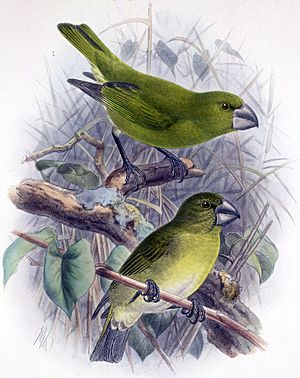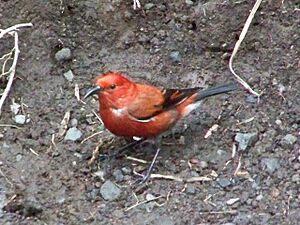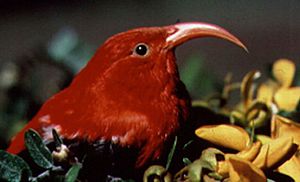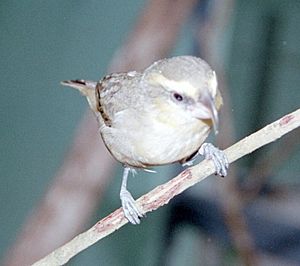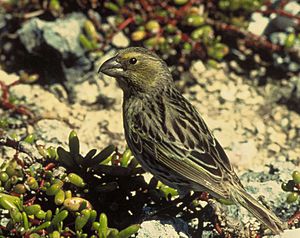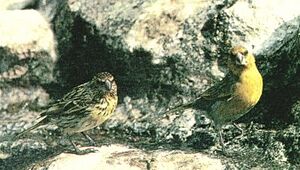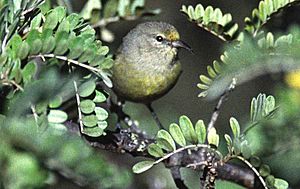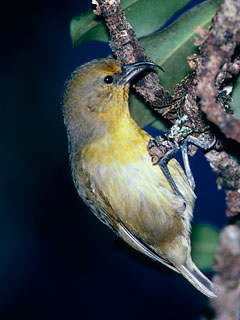List of adaptive radiated Hawaiian honeycreepers by form facts for kids
Hawaiian honeycreepers are a special group of birds found only in Hawaii. They are famous for their amazing ability to change and adapt, which scientists call adaptive radiation. This means that from one original type of bird, many different kinds evolved over time. Each kind developed unique beaks and behaviors to help them find food in different ways.
Sadly, many of these unique honeycreepers have become extinct, meaning they are no longer alive anywhere in the world. This happened especially after Europeans arrived in Hawaii. Things like new diseases, predators, and changes to their homes (habitats) caused many species to disappear. This article will explore some of the fascinating forms these birds took, both those that are gone and those that are still with us.
Contents
Honeycreepers with Finch-like Beaks
Some Hawaiian honeycreepers have strong, thick beaks, much like a finch. These beaks are perfect for cracking open tough seeds or crushing fruits.
Extinct Finch-like Honeycreepers
One example of an extinct finch-like honeycreeper is the Kona grosbeak (scientific name: Psittirostra kona). This bird had a very powerful beak, which it used to eat the hard seeds of the naio tree. It lived in the dry forests of the Big Island of Hawaii.
Surviving Finch-like Honeycreepers
Not all finch-like honeycreepers are gone! The 'Apapane (Himatione sanguinea) is a beautiful red bird that is still common today. While it has a finch-like beak, it mostly sips nectar from flowers, especially the red blossoms of the 'ōhi'a lehua tree.
Honeycreepers with Hummingbird-like Beaks
Some honeycreepers developed long, curved beaks, similar to those of a hummingbird. These beaks were perfect for reaching deep into flowers to drink nectar.
Extinct Hummingbird-like Honeycreepers
A famous example of an extinct hummingbird-like honeycreeper is the Hawai'i 'akialoa (Hemignathus obscurus). It had an incredibly long, downward-curving beak. This beak was perfectly shaped to get nectar from long, tubular flowers, especially those of the Hawaiian lobelioid plants.
Surviving Hummingbird-like Honeycreepers
While true hummingbird-like honeycreepers are all extinct, one surviving species, the 'I'iwi (Vestiaria coccinea), has a long, curved beak that helps it drink nectar. It's a bright orange-red bird and is often seen feeding on the nectar of lobelioid flowers, just like the extinct 'akialoa.
Honeycreepers with Parrot-like Beaks
Some honeycreepers developed beaks that look a bit like a parrot's. These strong, hooked beaks are good for tearing into fruits or wood.
Extinct Parrot-like Honeycreepers
The 'O'u (Psittirostra psittacea) is an extinct honeycreeper with a parrot-like beak. It was known for eating the fruits of the 'ie'ie vine.
Surviving Parrot-like Honeycreepers
There are a few surviving honeycreepers with parrot-like beaks.
- The Maui parrotbill (Pseudonestor xanthophrys) is a unique bird found only on Maui. It has a very strong, hooked beak that it uses to tear apart branches and find insect larvae hidden inside.
- The Laysan finch (Telespiza cantans) and the Nihoa finch (Telespiza ultima) are two other surviving species with strong, parrot-like beaks. They live on small, remote islands and eat seeds and insects.
Honeycreepers with Warbler-like Beaks
Some honeycreepers have smaller, pointed beaks, similar to a warbler. These beaks are good for catching insects or sipping nectar from smaller flowers.
Surviving Warbler-like Honeycreepers
The Common amakihi (Hemignathus virens) is a common and widespread honeycreeper with a warbler-like beak. It can be found on several Hawaiian islands, though it is no longer found on Lanai. It uses its beak to sip nectar and catch insects.
Honeycreepers with Woodpecker-like Beaks
One very specialized honeycreeper developed a beak that works a bit like a woodpecker's.
Surviving Woodpecker-like Honeycreepers
The 'Akiapola'au (Hemignathus wilsoni) is a truly unique bird. It has a strange beak with a short, strong lower part and a long, curved upper part. It uses the lower part to tap on tree bark, listening for insects, and then uses the long upper part to pull them out, much like a woodpecker. It is found only on the Big Island of Hawaii.
See also
- Hawaiian honeycreepers
- Adaptive radiation
- Honeycreepers


